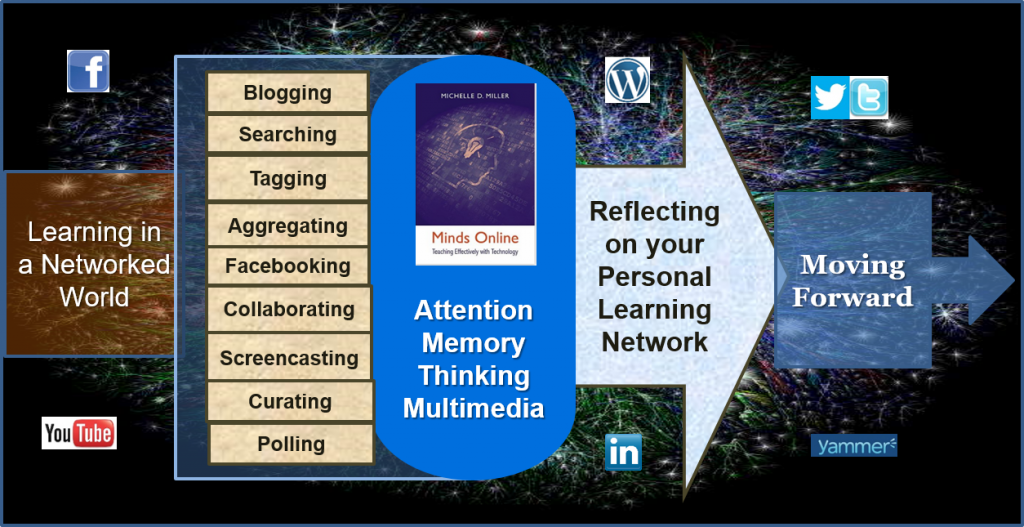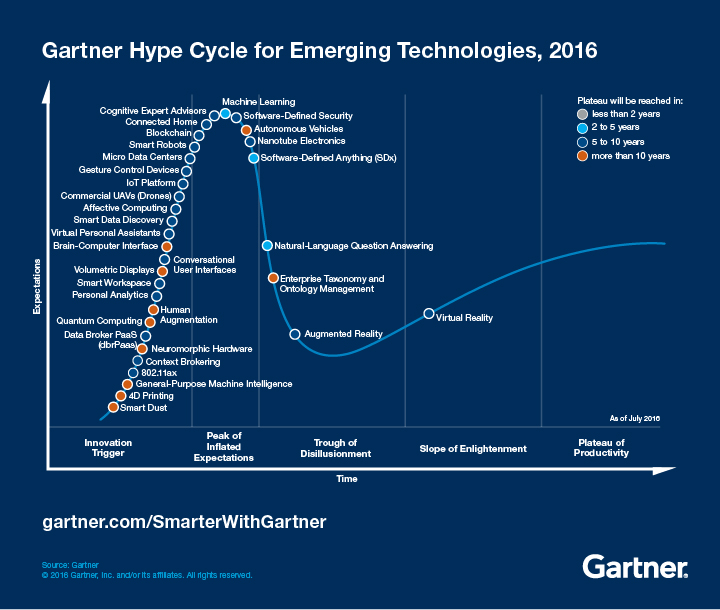A few days ago, I discussed my upcoming doctoral class on leadership in a wired world. I will also be teaching a Masters of Education course starting next week. EDU 6323 at Northeastern University is entitled Technology as a Medium for Learning. We explore aspects of digital technology through the lens of Michelle Miller’s (2014) book, Minds Online: Teaching effectively with technology. My course (adapted from one developed by Stan Anamuah-Mensah at VCU) flows like this:
I would like to think that this course explores “smart” uses of digital technology for learning…but “smart” has nuanced meaning now. We are seeing more and more application of AI in our everyday life. Just examine the Gartner Hype Cycle for Emerging Technologies.
Smart dust, smart workspace, smart data discovery, smart robots…there are a lot of smart applications emerging! Two books that I have read recently around smart technology are Martin Ford’s (2015) Rise of the Robots: Technology and the Threat of a Jobless Future, and Kevin Kelly’s (2016) The Inevitable: Understanding the 12 technological forces that will shape our future. One scary…one hopeful…and both directly applicable to this course!
So I read with interest a short article this week in MIT’s Technology Review by Hossein Derakhshan. In “A Smarter Web”, Derakhshab suggests that we need more text and links, and fewer images, videos and memes. He noted how the early days of the web and it’s text-based blogs served to nurture varying opinions, while lately, social media apps like Facebook, Twitter and SnapChat have served to amplify existing beliefs, polarizing and fragmenting society. He suggests that the lack of varying opinions had more to do with the outcome of the recent USA Presidential elections than false news. Derakhshan suggests that a smarter web would be one that stepped backwards in time.
As I mentioned in my previous post, we are moving as a nation into a future where the old rules seem to have shriveled. Robert Reich noted earlier this week that Trump’s tweets are becoming a new form of governing by edict..or “Tweedict” as he termed them. In my EDU 6323 course, we will be using Twitter as a form of class communication using the hashtag #EDU6323…but hopefully in a more collaborative way than the Tweedict suggests!
In the third week of the course, we will explore validity on the web. I am adding danah boyd’s recent Medium article – “Did Media Literacy Backfire” – to the reading for that week. danah noted that media literacy asks people to question information and be wary of what they are receiving…but, in line with Derekhshan’s article, this has led to where we are questioning so much that we talk right by each other. danah ends her article noting:
“The path forward is hazy. We need to enable people to hear different perspectives and make sense of a very complicated — and in many ways, overwhelming — information landscape. We cannot fall back on standard educational approaches because the societal context has shifted. We also cannot simply assume that information intermediaries can fix the problem for us, whether they be traditional news media or social media. We need to get creative and build the social infrastructure necessary for people to meaningfully and substantively engage across existing structural lines. This won’t be easy or quick, but if we want to address issues like propaganda, hate speech, fake news, and biased content, we need to focus on the underlying issues at play. No simple band-aid will work.”
So I know that my course will engage students and introduce them to new technologies. But my hope is that my course will also begin to shift some paradigms and shake up some cultural norms. Otherwise, their future students might not hear these different perspectives that they need to hear! And that would not be smart!

